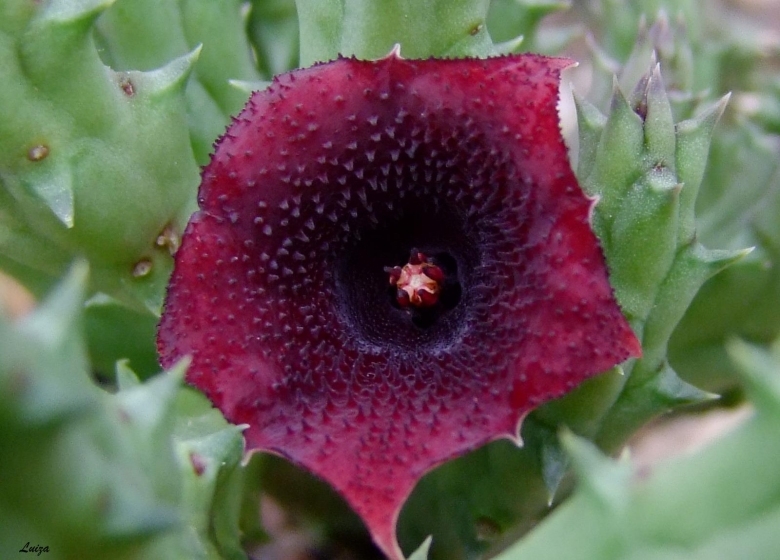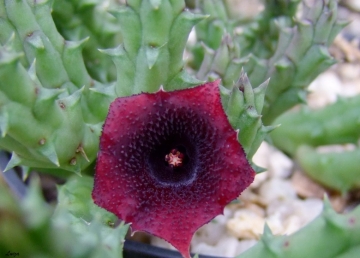Accepted Scientific Name: Huernia saudi-arabica D.V.Field
Kew Bull. 35(4): 754. 1981 [28 Apr 1981]

Huernia transmutata Photo by: Luiza Ferreira
Synonyms:
See all synonyms of Huernia saudi-arabica
back
Accepted name in llifle Database:Huernia saudi-arabica D.V.FieldKew Bull. 35(4): 754. 1981 [28 Apr 1981]Synonymy: 2
back
Description: Huernia transmutataSN|28288]]SN|30531]] is a poorly known taxon which may not be a good species possibly a form of Huernia saudi-arabicaSN|30531]]SN|28288]], it forms a small prostrate clumps about 5-7 cm high made of thick succulent green branches that take a brown tinge in the sun. Its star-shaped flowers are 2 cm diameter of an astonish intense purple-black colour.
Subspecies, varieties, forms and cultivars of plants belonging to the Huernia saudi-arabica group
 Huernia saudi-arabica D.V.Field: flowers bell-shaped to 40 mm wide, deep purplish-red with raised whitish-yellow papillae. Distribution: Asir, SW of Taif. Saudi Arabia.
Huernia saudi-arabica D.V.Field: flowers bell-shaped to 40 mm wide, deep purplish-red with raised whitish-yellow papillae. Distribution: Asir, SW of Taif. Saudi Arabia. Huernia transmutata A.C.White & B.Sloane: possibly a form of H. saudi-arabica Its star-shaped flowers are 2 cm diameter of an astonish intense purple-black colour.
Huernia transmutata A.C.White & B.Sloane: possibly a form of H. saudi-arabica Its star-shaped flowers are 2 cm diameter of an astonish intense purple-black colour.
Bibliography: Major refrerences and further lectures
1) A.C.White & B.Sloane “Stapelieae” ( White & Sloane) ed. 2 3: 855 Abbey San Encino Press, 1937
2) Focke Albers, Ulrich Meve "Illustrated Handbook of Succulent Plants: Asclepiadaceae" Volume 4 Springer, 2002
3) Luckhoff “The Stapelieae of Southern Africa” Capetown, A.A. Balkema 1952
4) Bruyns, P.V. 2005. “Stapeliads of southern Africa and Madagascar.” Vol. II. Umdaus Press, Hatfield.
5) James Cullen, Sabina G. Knees, H. Suzanne Cubey “The European Garden Flora Flowering Plants: A Manual for the Identification of Plants Cultivated in Europe, Both Out-of-Doors and Under Glass” Cambridge University Press, 11/ago/2011
6) Gideon Smith, Neil R. Crouch “Guide to Succulents of Southern Africa” Struik Nature, 01/nov/2009
 Huernia transmutata Photo by: Luiza Ferreira
Huernia transmutata Photo by: Luiza FerreiraSend a photo of this plant.The gallery now contains thousands of pictures, however it is possible to do even more. We are, of course, seeking photos of species not yet shown in the gallery but not only that, we are also looking for better pictures than those already present.
Read More... Cultivation and Propagation: Huernia transmutataSN|30531]]SN|30531]] isn't difficult to grow and flower.
Spring: When winter ends and they begin to grow again, they will require much water and soaking the pots will no longer put the plants at risk for rot. In the spring they will grow well in partial shade and leaving them out in the rain may provide them with the water they need.
Summer: In the summer months they will tolerate heavy rain, but will be just as happy if the season is dry. It's best to sort out the stems while the plants are resting in the summer before they begin their autumnal growth cycle. They will tolerate very hot weather outdoors as long as they are kept in filtered light and this will encourage them to flower in the Autumn. They also enjoy some fertiliser. Moving the plants as they are developing buds may cause them to spontaneously abort the flowers all together.
Autumn: In the fall keep them outdoors until the night time temperatures drop below the 5°C.
Winter: Winter care presents no problems at 5°-10° C with plenty of light. As soon as they are flowered be sure to take extra precautions to keep them dry, because damp cool conditions when the plants are resting is an invitation to fungal infections, but - according to temperatures –some occasional lit watering may be useful.
Potting medium: Since roots are quite shallow, use a cactus mix or add extra perlite or pumice to regular soil potting soil. A gritty, very free-draining compost is suitable, and clay pots help the plants to dry out between watering. Re-pot every 2 years.
Pest and diseases: Huernia are generally fairly easy to grow, especially if kept pest-free. They are very susceptible to stem and root mealy bugs, and damage from these may well initiate fungal attack. Any time when there is a dead or dying stem in the pot it is important to remove it immediately and completely before other healthy stems can become ill too, isolate the healthy parts, dry them off, and re-root them in new compost.
Propagation: Easiest with stem cuttings. Allow cuttings to dry a day before planting. Stems must be laid (Not buried) on gritty compost and will then root from the underside of the stems. It can also be increased from seeds sowing in spring in moist, sandy peat moss. Barely cover seeds. Seeds germinate quickly.
In any season it's best to lay the stems out for several days before replanting them and then pot them only in dry soil and withhold any water until they begin to shrivel or start growing again.












